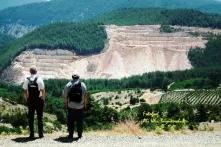
On the evening of September 9th this year hundreds of construction workers started building a new road through the forest on the campus of the Middle East Technical University (METU) in Ankara. The trucks and excavators were accompanied by hundreds of policemen to prevent possible resistance and demonstrations.
Since 1992, several attempts have been made by the Ankara Metropolitan Municipality to use certain parts of the campus area for road construction, all of which faced severe resistance. In 2013 during the biggest of these protests solidarity actions were organized in other cities. Ahmet Atakan, one of the protestors was killed during the demonstration.
Due to a recent protocol signed between the METU administration, the Ankara Governorship and the Ankara Metropolitan Municipality, thousand of trees of the METU forest within the campus area, which have been planted throughout the last four decades by the university staff and students were eventually cut down.
For years the METU forest has been referred to as the “lungs of Ankara”, representing a large ecosystem providing life and space for various animals and plants. Since 1960, following a joint call by METU and the Ministry of Forestry, 10 million coniferous and more than 20 million leaved trees were planted into the 3,1 thousand hectare wide area. In 1995, the Ministry of Culture declared the METU forest a natural and archeological protected site. In the same year the METU forestation project was given the International Aga Khan Architecture Award for its contribution to “our world where ecological values are steadily degenerating”. Long lasting efforts of the university to green the initially arid land were also awarded by the TEMA Foundation – Turkey’s largest environmental NGO - in 2003.
The reason this project is so controversial does not only lie in the destruction of parts of the forest. The new road is meant to serve as a shortcut to Bilkent University where a new hospital is currently being built. While the shortcut would provide traffic relief for Ankara’s streets once people start flowing to the new hospital, the politisation of the issue stems from the nature of the hospital project itself. It is part of the “city hospitals project” that divides 81 Turkish cities into 29 regions and envisages the construction of big hospital complexes in each of these regions. The amount of the investment is enormous: 10 billion US Dollars are planned to be spent on the construction of those complexes via a public private partnership. In the case of the Bilkent City Hospital e, which is referred to as the “biggest in Europe”, the investor DIA Holding will be able to manage the hospital for 25 years whereby the state will be their tenant, paying them an initial rent of 340 million TL (82 mil. €) annually adjusted for inflation rates. As the state guarantees the investor a 70% occupancy guarantee, many believe that already existing state hospitals in the respective cities will eventually be closed to meet this goal. The closure of the existing hospitals in various neighborhoods of Ankara, some of them being long-established university hospitals located in low income areas, is considered by city planners as a significant threat to the local economy of those places which already undergo processes of collapse due to recent urban policies.



